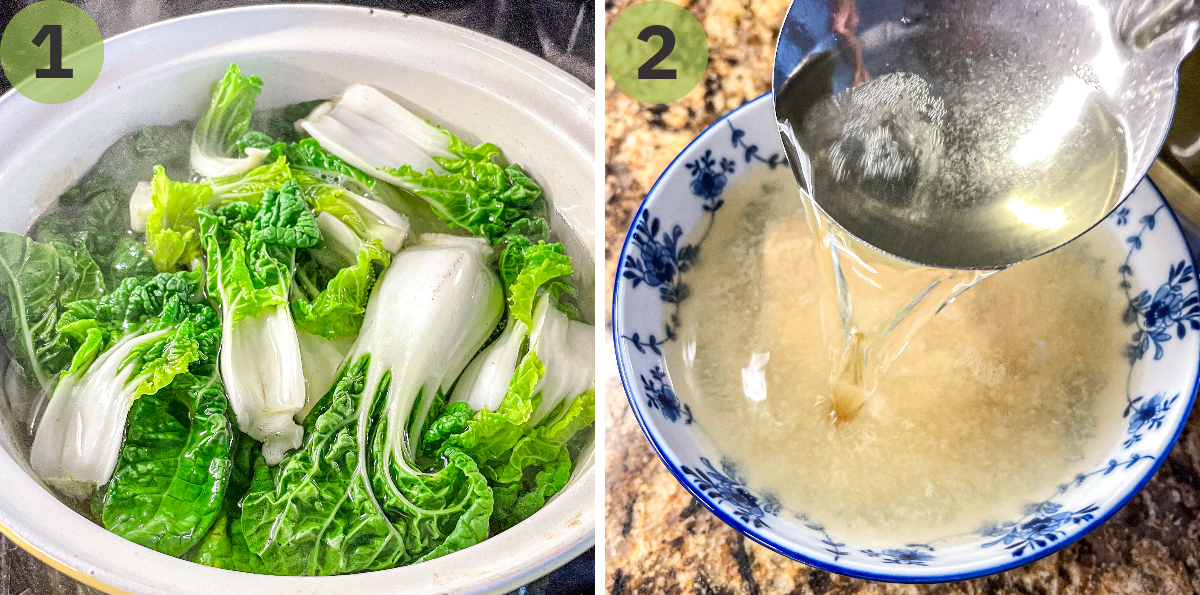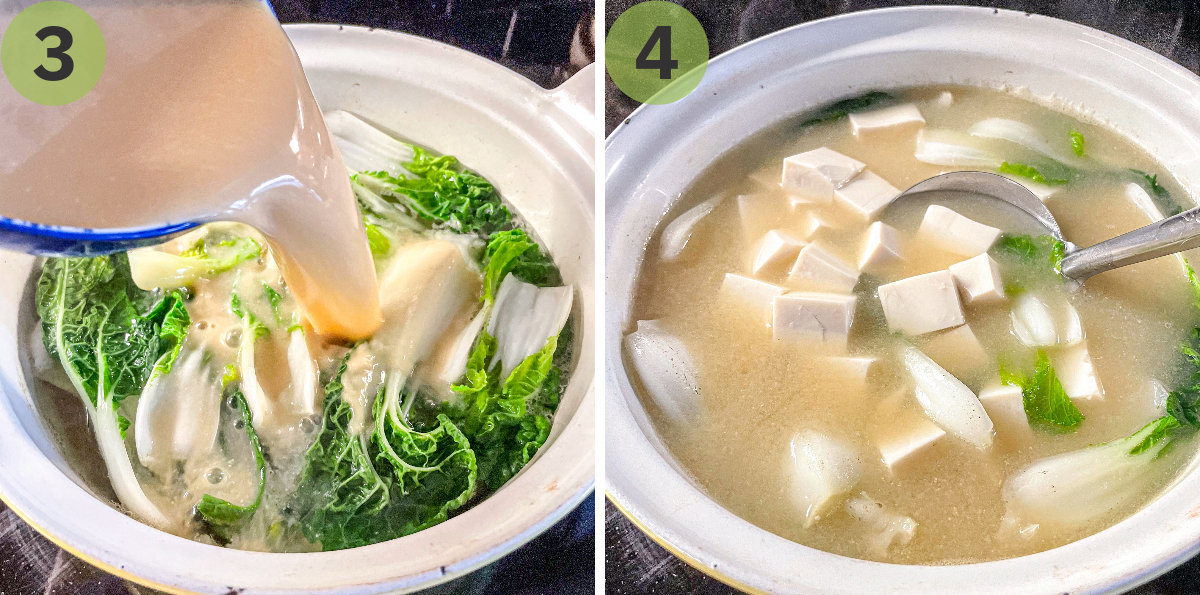When it comes to miso soup, I keep it minimal to really let the miso paste shine through. This Bok Choy Miso Soup has only five ingredients so the flavours are clear, not muddy. Put this light and elegant side dish on your table in under 20 minutes.

Bok choy and miso paste are great partners. In fact, most Asian leafy greens go well with miso. You could use Napa cabbage, yu choy, or water spinach, if you don’t have bok choy. It’s a great way to use up an abundance of leafy veg in your fridge. And you get a hit of savoury, fermented probiotic goodness to boot!
Ingredients + Substitutions

Bok choy miso soup is gluten-free, oil-free, low-carb and whole foods plant-based. Let’s take a look at some of the ingredients:
Dashi Granules: Also known as dashi powder or instant dashi. It’s made from kombu (kelp seaweed), a natural source of umami. It’s the quickest way to add savoury Japanese flavours to any soup. If you’re vegan or vegetarian, make sure the product is labelled vegetarian. Many dashi powders contain fish.
Dashi Substitution: You can make your own dashi from scratch using kombu and shiitake mushrooms. Check out my Soondubu Jjigae recipe to learn how. Or, substitute with vegetable stock or bouillon cubes.
Baby Bok Choy: Use baby bok choy, so you can keep the leaves whole and still manageable to eat. Or you can also use Napa cabbage, yu choy, or water spinach—just chop them into smaller bite-size pieces.
Bok Choy vs Shanghai Bok Choy: You might see two types of baby bok choy in the supermarket: regular bok choy, and Shanghai bok choy. They look similar but are easily distinguishable. Regular bok choy has green leaves and white stems. Shanghai bok choy is green all the way through, from the stems to the leaves. They taste very similar, so you can’t go wrong with either variety.
Tofu: Any kind of tofu works here, from silken tofu to firm tofu or even extra-firm. It’s a flexible recipe! I like using Mori-Nu Soft Tofu. It has a smooth, silky texture but it’s not too fragile.
Miso Paste: I use white miso paste, which is more mellow. The more intense red miso paste works great too. Most miso soups in North America are made with white or yellow miso paste, but when I was in Japan I noticed mainly red miso soups. It definitely has a stronger flavour. Find miso in the refrigerated section of your local Asian grocery store or health food store.
For a full list of ingredients and quantities, refer to the recipe card at the bottom of this post.
Flavour Variations
- Miso Noodle Soup: Turn bok choy miso soup into a full meal by throwing in some fresh udon noodles near the end of cooking.
- Furikake Miso: Sprinkle a handful of Nori Komi Furikake (or other Japanese seasoning of your choice) over each bowl of soup.
- Mushrooms and Sesame Oil: Throw in some oyster mushrooms or enoki mushrooms and a splash of toasted sesame oil to make a heartier, richer miso soup.
- Tomato Miso: Add a cupful of cherry tomatoes to make tomato tofu miso soup. (This was one of the gorgeous dishes featured in the Japanese show The Makanai. I never though to combine tomatoes and miso soup until seeing this show, but it’s actually a pretty good combo.)
Step-by-Step Process

Step 1: Add the dashi granules, water, and bok choy to a stock pot or donabe. Set it on medium heat and bring to a simmer. While you’re waiting, take this time to slice the tofu into small cubes.
Step 2: Ladle out a few spoonfuls of the hot broth into a bowl and mix it with the miso paste until fully dissolved. Meanwhile, continue to simmer the soup until the bok choy is cooked to your liking.
Tip: The traditional Japanese method calls for mixing miso paste with a small amount of broth instead of stirring it directly into the boiling soup. Why? There are two reasons: 1) the probiotic cultures in miso are killed at high temperatures, and 2) boiling hot water makes miso turn bitter.

Step 3: Turn off the heat and pour the miso mixture back into the pot.
Step 4: Stir in the cubed tofu just to heat through, and serve.
Meal Prep & Storage Tips
If you’re meal prepping this soup for later, I recommend undercooking the bok choy for a couple minutes. This ensures they will stay green and crisp when you reheat them.
Fridge: Refrigerate bok choy miso soup in an airtight container for up to five days.
Freezer: I haven’t tried freezing this recipe yet. Let me know if you do!
Recipe FAQs
To enhance the flavor of miso soup, consider adding complementary ingredients such as scallions, sesame oil, nori seaweed, and furikake. You can also add ingredients like mushrooms, cherry tomatoes, and noodles (see my Flavour Variations section above for details). These additions provide textural variety and contribute some interesting flavourful elements to the soup. You can also incorporate vegetables like spinach, bok choy, or daikon radish for added freshness and nutritional value.
Yep, traditional Japanese cooking advice suggests to not add miso paste directly to boiling soup. Boiling miso soup at high temperatures can diminish its flavor and reduce its health benefits. Miso is a fermented ingredient, and boiling it may kill off the beneficial live cultures within miso. Instead, it’s recommended to add miso paste towards the end of the soup-making process, once the heat has been reduced or turned off. This way, the miso retains its rich, nuanced taste and nutritional benefits, ensuring a more authentic and flavorful miso soup.
Miso soup goes well with many Japanese dishes, including steamed rice, sushi or sashimi, or salted edamame. The light and savory broth also complements most Asian leafy greens such as bok choy, choy sum, and tong ho. To complete the Japanese dining experience, a cup of green tea (such as matcha, sencha, hojicha) can provide a refreshing touch.
More Japanese Recipes

Recipe Card
Did you make this recipe? Please consider leaving a rating below to let me know how you liked it.
You can also take a picture and tag me on Instagram @earthtoveg, I will shout you out in my Stories!

Bok Choy Miso Soup
Use Imperial/Metric buttons below to toggle between volume vs weight measurements. I recommend weighing out your ingredients for best results.
Equipment
- Stock pot, Dutch oven, or donabe
- Soup ladle
Ingredients
- 2 tsp dashi granules I use Shimaya Kombu Dashi Powder; see Note 1
- 4 cups water
- 8 oz baby bok choy
- 8 oz tofu I use Mori-Nu Soft Tofu but any kind of tofu works here
- 5 tbsp miso paste
- 2 scallions, diced *optional, for topping
Instructions
- Add dashi granules, water, and bok choy to a stock pot or donabe. Set it on medium heat, cover, and bring to a simmer. While you’re waiting, take this time to slice the tofu into small cubes.
- Ladle a few spoonfuls of the hot broth into a bowl. Mix it with miso paste until the miso is fully dissolved (see Note 2).
- Meanwhile, continue to simmer the soup for a few more minutes until bok choy is cooked to your liking (1–3 minutes).
- Turn off the heat and pour the miso mixture back into the pot.
- Stir in the cubed tofu just to heat through, and serve. Top with scallions if using.
Notes
- Dashi is a type of Japanese soup stock made from kombu (kelp), a natural source of umami. It’s the base of most miso soups. You can make your own dashi from scratch using kelp and mushrooms (see my Soondubu Jjigae recipe). But instant dashi granules (aka dashi powder) are also great in a pinch. If you’re vegan or vegetarian, just make sure the product is labelled vegetarian. Many dashi powders contain fish.
- Miso: The traditional Japanese method for miso soup is to mix miso paste with a small amount of broth instead of stirring it directly into the boiling soup. Why? There are two reasons: 1) the probiotic cultures in miso are killed at high temperatures, and 2) boiling hot water makes miso turn bitter.
